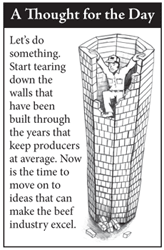



The Plight of Being Average
With rising input costs and falling calf value, survival in the beef business is a very real question for many producers, writes Kris Ringwall, Beef Specialist, North Dakota State University.
The cattle business is a profession that requires considerable education and experience. In other words, the managerial inputs need to be well thought out so that the ramifications or consequence of doing or not doing something has the desired outcome.
With rising input costs and falling calf value, survival in the beef business is a very real question for many producers. Unfortunately, our simple willingness to do what we have previously done is a major impediment to moving forward. At the end of the year, if the dollars and cents are added up and the bottom line is pathetic, what does it take to move from the status quo to a more proactive thought process?
It is not easy, but if a producer wishes to remain in the beef profession, reality needs to be addressed. If we were to review the numbers, a good source is the 2008 annual report for the North Dakota Farm and Ranch Business Management Education Program (http://www.ndfarmmanagement.com).
As has been noted before, if the 119 producers engaging in a cow-calf enterprise are sorted by net return per cow, assuming 100 cows in the herd, then the lower 20 per cent lost $15,378. The middle or average producer made $1,521 and the top 20 per cent of producers made $13,025.
These net returns do not include a charge for labor and management, so the average beef producer has $1,521 to pay himself or herself for his or her effort. There is another way to tap reality. If a typical summer job pays $10 per hour, the average producer could have worked four weeks off the farm or ranch and made more money than was made in the beef business. Just as those producers who are not making a profit, the average producer needs to look at the operation and ask just what is the primary product produced on the farm or ranch.
In the annual report, one can approximate that the average cow-calf producer fed 104 tons of corn silage valued at $21 per ton, 21 tons of alfalfa hay valued at $58 per ton and 259 tons of hay valued at $40 per ton.
If one was to assume these forages were produced on the ranch (the report does not indicate the source of forage), then those values were retrieved by marketing the forage through the cows. The function of ruminate animals is to convert forage into a marketable product.
If I was to sum up the plight of the average beef producer, the work is hard, the pay negligible, but the farm or ranch forage was marketed at reasonable prices, and the producer is certainly worthy of being in the forage business. Are the cows the right tool to add value to the forage from the operation is the obvious next question. It is a good question and worth asking of a professional cattle person. The answer is not simple and that is why average producers should not seek to remain average because there will come the day when it is easier to simply market the forage and let someone else feed it.
Average producers must dismiss the innate willingness to accept the current negatives based on an optimistic wish that next year will be better. Many producers, perhaps too many, have come to accept the concept that going backwards occasionally is an accepted principle in agriculture. Such thinking leads to the principle that the bank will carry us for another year and the upcoming good years will bail us out.
However, if, as beef producers, we simple choose to remain average, in reality, the good years only will bring us back to break even. We can and must do better. We must become professionals who truly use our education and experience to excel in the beef business.
Let’s do something.
Take a deep breath, look up and jump as high as you can. Keep jumping until you can see over all the walls one has built up through the years. Even though the vision may not be clear, make the commitment to grab the top of one those walls and tear it down. When you land and the wall is lying at your feet, look out and simply say I can do this.
Now step over the rubbish and let’s move on. More later.
May you find all your ear tags.
June 2009


